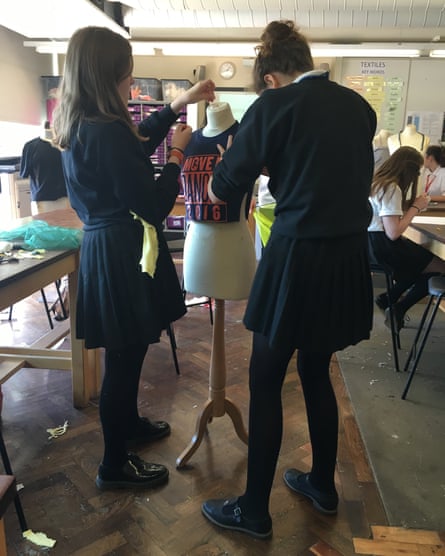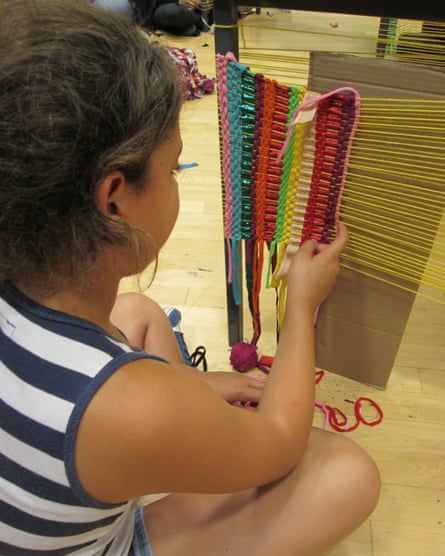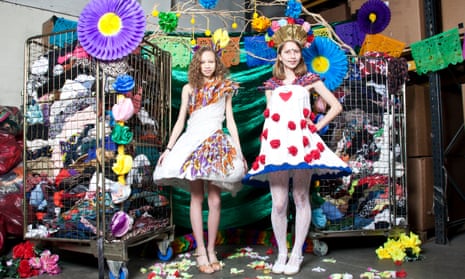How much did your outfit cost? Chances are, much more than you think. The clothing industry is the second-largest global polluter – after oil – and its complex production techniques and supply chains create a myriad of environmental issues. It takes 2,700 litres of water to make one t-shirt, and an estimated £140m worth of clothing [pdf] goes to landfill sites in the UK annually.
The need for change is urgent – and education can play a key role in championing new attitudes towards clothing. Some schools are now working with organisations to explore the impact of the fast fashion industry.

Photograph: Traid
“The clothing business model is built on volume and getting the clothes produced as cheaply and quickly as possible – buy cheap, wear a few times and then throw away. This is not a sustainable model for our environment,” says Sarah Klymkiw, head of education at Traid, a UK charity working to reduce the environmental and social impacts of clothing waste.
Learning lifecycles
Traid runs programmes at primary and secondary levels. It reaches 10,000 students per year and provides in-depth, interactive workshops on issues such as the lifecycle of clothing, upcycling and mending, to citizenship, geography and technology for older students.
“We want to deepen understanding, then engage students in thinking critically about which stakeholders are responsible for the environmental and social impacts of the fashion industry – and what can be done about it,” says Klymkiw. “We have free downloadable resources for teachers on our website, which include lesson plans and presentations to use in the classroom. We also have useful videos on our Traidfilms YouTube channel.”
Aurora Thompson teaches design and technology at Haggerston School, east London. The school has worked with Traid on a sustainable fashion programme, which is particularly pertinent to the subject Thompson teaches: “Every scheme of work in design and technology has sustainability issues embedded, such as using recycled materials, understanding the complex issues within the textiles industry and the life cycle of products.”
The programmes at Haggerston School were aimed at two age groups; the year 10s took part in upcycling workshops, while the year 11s were given lectures. Thompson continues: “The workshop promoted group work and developed students ability to work well in teams, while the lectures consolidated the year 11’s understanding of sustainability.”
For some pupils, the course has been inspiring: “It has given them a new insight into their own consumption of fashion. A few students from this class have subsequently volunteered to help run a Fairtrade week at school.”

Photograph: Traid
Carol Fitzwilliam, design and technology, arts and textiles, teacher at Queens Park Community school, was inspired to design a sustainable fashion programme after an initial session with Traid: “We worked with the year nine students on what they could do with old shirts. They worked in teams and set about restyling them to various degrees of success. The project worked well as it involved a personal journey for a garment no longer wanted. It made them think twice about all the cheap clothes they buy.”
Fashion Revolution offers a selection of educational resources through its website, and its areas of outreach include 2015’s Fashion Revolution Arts and Speaker Tour, which visited universities to raise awareness of issues in the fashion industry. It also hosts regular talks and exhibitions in colleges around the UK.
“Most schools and universities are beginning to see education in sustainability as essential to the formation of the next generations, and not just in fashion,” says founder and creative director Orsola de Castro. “In fact, perhaps in fashion we lag behind.”
The organisation uses case studies, such as one detailing the impact of the lifecycle of a pair of jeans. De Castro says this exemplifies “the full social and environmental impact, from farming cotton through to the dyeing and making processes”.
The societal impacts of the fashion industry – such as global welfare, employment and equality – are also important classroom discussions. According to a Clean Clothes Campaign report, 75 million people are employed in the textile industry. Three-quarters of those garment workers are women and many work in low-paid, unregulated positions.
Social media and selfies
The Leys, a school in Cambridge, has worked with Fashion Revolution on education programmes. Andrew Harmsworth, a coordinator for World AIMS (a project to help learners find out more about the world around them) at the school, highlights the practical impacts of discussing fashion in the classroom.
He says their conversations have had a “profound influence on pupils, as it revealed to them what most of us only had a vague idea about: that the things we buy are made by people far away and that our choices can greatly influence whether the purchase is associated with heaps of negatives, or is a purchase that causes positive change.”
Teacher Denz Fernandes adds: “Over recent years we have participated in social media campaigns through Fashion Revolution’s #WhoMadeMyClothes hashtag. Students and staff had items of clothing and took selfies with the label showing. These photos were then sent via social media to the producers of the clothes.”
So are there hurdles to giving young people new perspectives on fashion? Clothing is one way that students begin to define themselves, be it through style or loyalty to a brand label. But Fitzwilliam believes that teaching about fast fashion can help alter some of these habits, and make young people think: “The usual ‘brand’ focus had to be put to one side. I think the students actually started to appreciate that it is sometimes a good thing to be unique and different.”
Projects such as these highlight exactly why teaching about fashion and its impacts is essential: it can provide an entry point into some of the most important and wide-ranging issues we face today, while bringing a relatable touchstone to students’ everyday lives.
“It’s a big issue,” says de Castro. “But hopefully if we act together we can overcome the apathy of having inherited a huge problem, and focus on being an active part of the solution.”
Follow us on Twitter via @GuardianTeach. Join the Guardian Teacher Network for lesson resources, comment and job opportunities, direct to your inbox

Comments (…)
Sign in or create your Guardian account to join the discussion